Understanding Health, Wellness, Illness, and Disease Concepts Report
VerifiedAdded on 2023/04/19
|9
|1796
|319
Report
AI Summary
This report provides a comprehensive overview of the concepts of health, wellness, illness, and disease. It begins by defining health according to various perspectives, including the WHO definition emphasizing mental, physical, and social well-being. The report then delves into wellness, differentiating it from illness and highlighting its dynamic nature and the importance of self-responsibility. Disease is defined, and the report categorizes it into infectious and chronic diseases. The core of the report examines the biopsychosocial model, illustrating the interplay of biological, psychological, and social factors in determining health outcomes, with specific examples of each. The report also analyzes various factors contributing to illnesses and includes a critical analysis of responses to health and wellness issues, emphasizing the role of physical therapists and cognitive behavioral theory. Finally, the report references relevant literature and concludes with a summary of the key concepts and the importance of the biopsychosocial model.
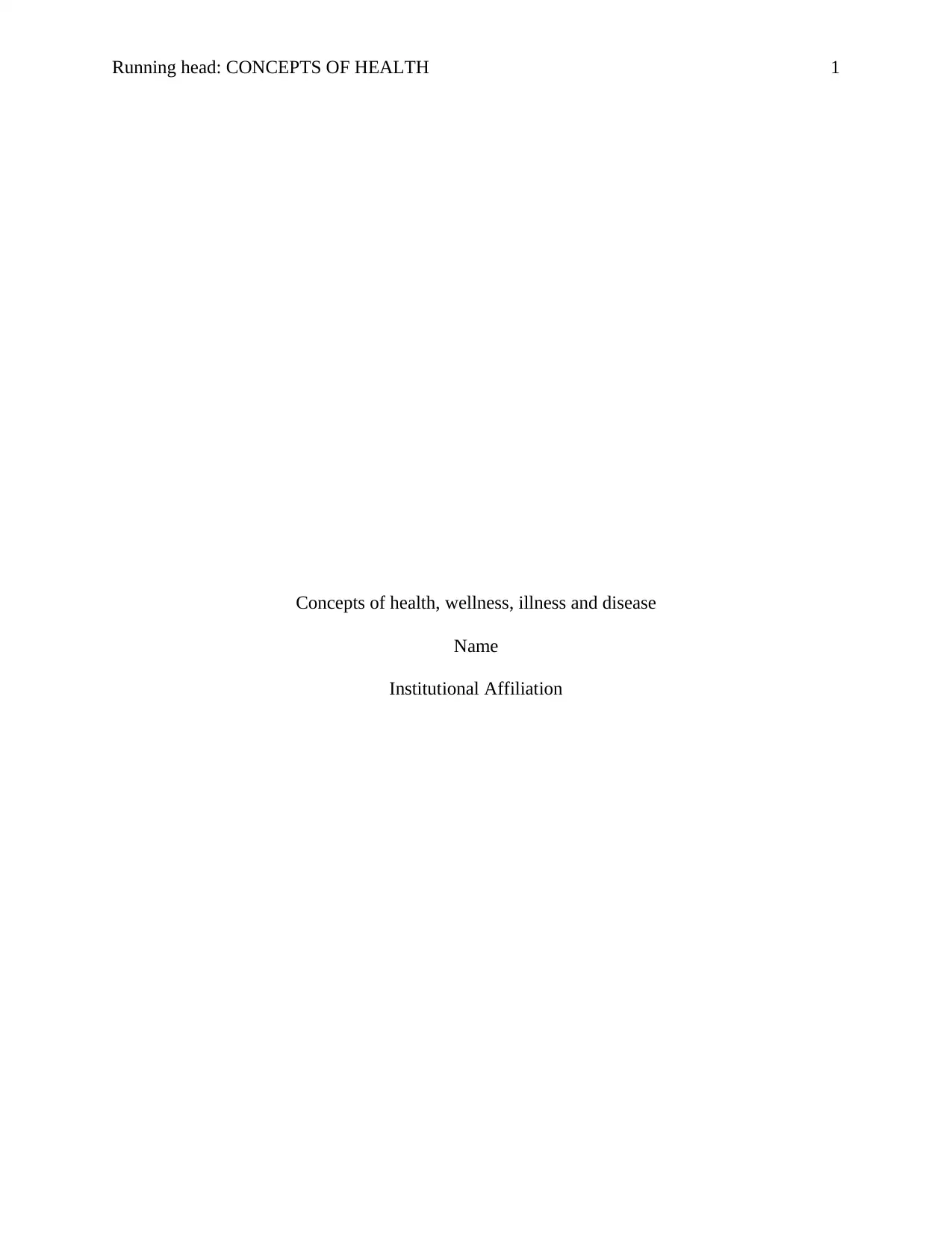
Running head: CONCEPTS OF HEALTH 1
Concepts of health, wellness, illness and disease
Name
Institutional Affiliation
Concepts of health, wellness, illness and disease
Name
Institutional Affiliation
Paraphrase This Document
Need a fresh take? Get an instant paraphrase of this document with our AI Paraphraser
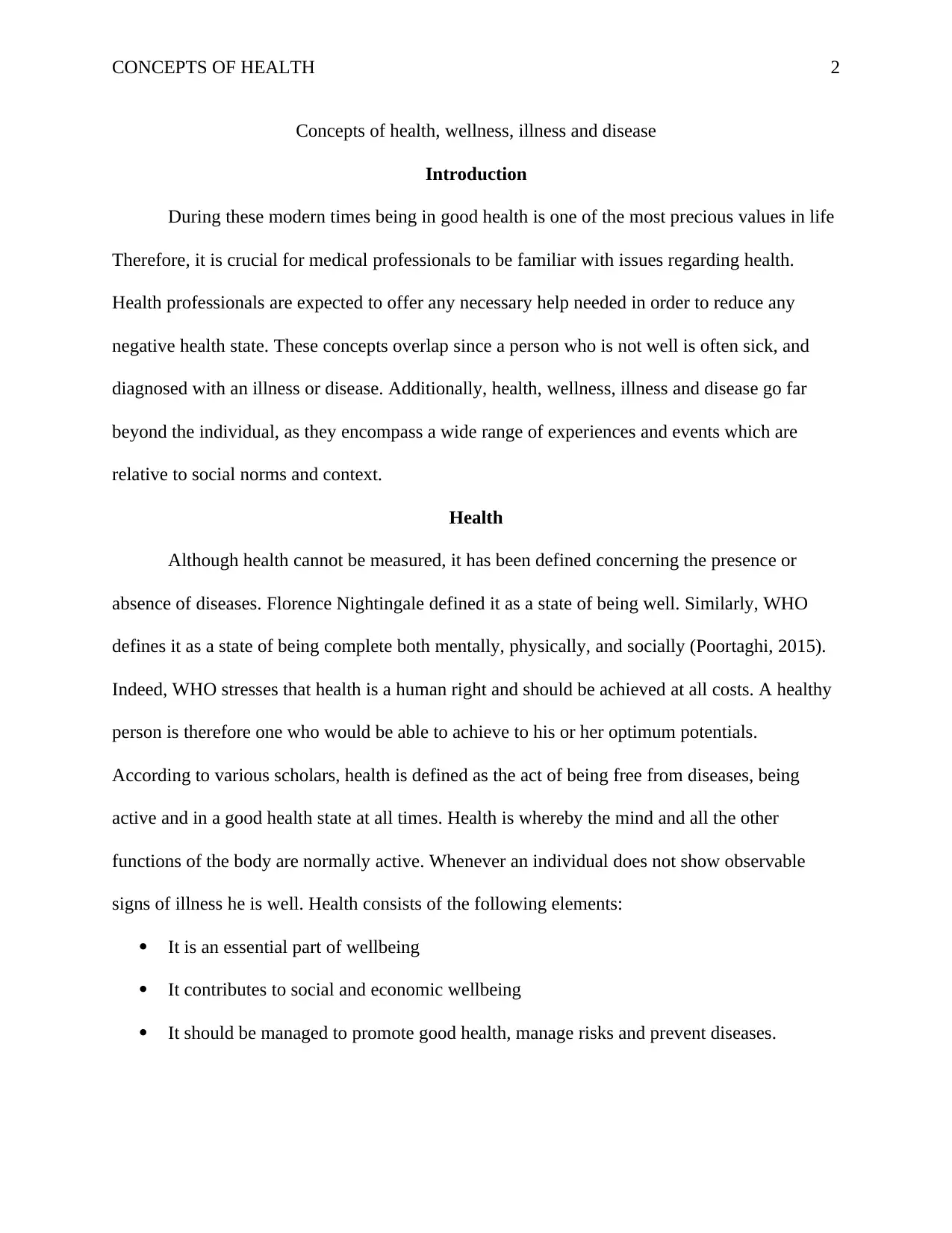
CONCEPTS OF HEALTH 2
Concepts of health, wellness, illness and disease
Introduction
During these modern times being in good health is one of the most precious values in life
Therefore, it is crucial for medical professionals to be familiar with issues regarding health.
Health professionals are expected to offer any necessary help needed in order to reduce any
negative health state. These concepts overlap since a person who is not well is often sick, and
diagnosed with an illness or disease. Additionally, health, wellness, illness and disease go far
beyond the individual, as they encompass a wide range of experiences and events which are
relative to social norms and context.
Health
Although health cannot be measured, it has been defined concerning the presence or
absence of diseases. Florence Nightingale defined it as a state of being well. Similarly, WHO
defines it as a state of being complete both mentally, physically, and socially (Poortaghi, 2015).
Indeed, WHO stresses that health is a human right and should be achieved at all costs. A healthy
person is therefore one who would be able to achieve to his or her optimum potentials.
According to various scholars, health is defined as the act of being free from diseases, being
active and in a good health state at all times. Health is whereby the mind and all the other
functions of the body are normally active. Whenever an individual does not show observable
signs of illness he is well. Health consists of the following elements:
It is an essential part of wellbeing
It contributes to social and economic wellbeing
It should be managed to promote good health, manage risks and prevent diseases.
Concepts of health, wellness, illness and disease
Introduction
During these modern times being in good health is one of the most precious values in life
Therefore, it is crucial for medical professionals to be familiar with issues regarding health.
Health professionals are expected to offer any necessary help needed in order to reduce any
negative health state. These concepts overlap since a person who is not well is often sick, and
diagnosed with an illness or disease. Additionally, health, wellness, illness and disease go far
beyond the individual, as they encompass a wide range of experiences and events which are
relative to social norms and context.
Health
Although health cannot be measured, it has been defined concerning the presence or
absence of diseases. Florence Nightingale defined it as a state of being well. Similarly, WHO
defines it as a state of being complete both mentally, physically, and socially (Poortaghi, 2015).
Indeed, WHO stresses that health is a human right and should be achieved at all costs. A healthy
person is therefore one who would be able to achieve to his or her optimum potentials.
According to various scholars, health is defined as the act of being free from diseases, being
active and in a good health state at all times. Health is whereby the mind and all the other
functions of the body are normally active. Whenever an individual does not show observable
signs of illness he is well. Health consists of the following elements:
It is an essential part of wellbeing
It contributes to social and economic wellbeing
It should be managed to promote good health, manage risks and prevent diseases.
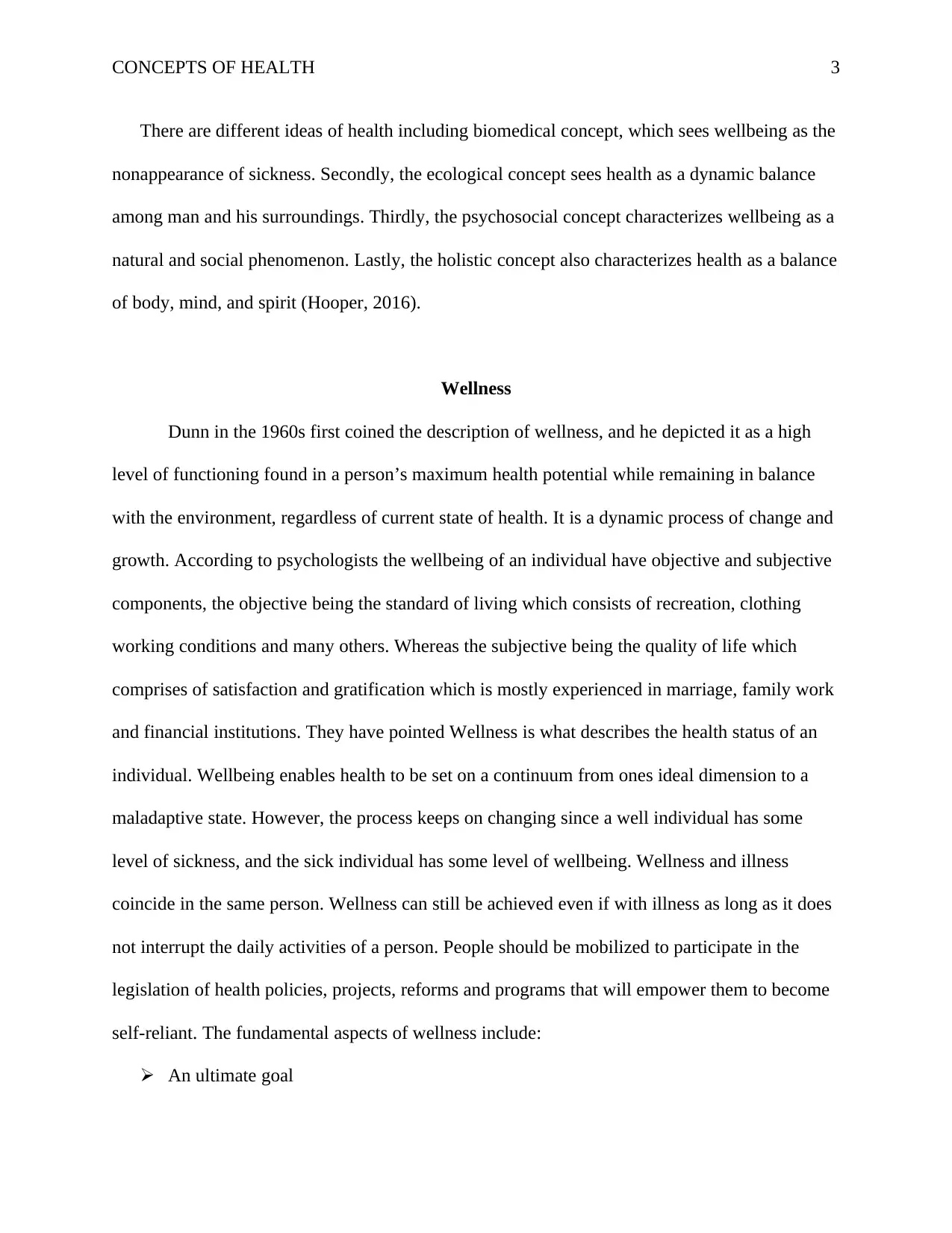
CONCEPTS OF HEALTH 3
There are different ideas of health including biomedical concept, which sees wellbeing as the
nonappearance of sickness. Secondly, the ecological concept sees health as a dynamic balance
among man and his surroundings. Thirdly, the psychosocial concept characterizes wellbeing as a
natural and social phenomenon. Lastly, the holistic concept also characterizes health as a balance
of body, mind, and spirit (Hooper, 2016).
Wellness
Dunn in the 1960s first coined the description of wellness, and he depicted it as a high
level of functioning found in a person’s maximum health potential while remaining in balance
with the environment, regardless of current state of health. It is a dynamic process of change and
growth. According to psychologists the wellbeing of an individual have objective and subjective
components, the objective being the standard of living which consists of recreation, clothing
working conditions and many others. Whereas the subjective being the quality of life which
comprises of satisfaction and gratification which is mostly experienced in marriage, family work
and financial institutions. They have pointed Wellness is what describes the health status of an
individual. Wellbeing enables health to be set on a continuum from ones ideal dimension to a
maladaptive state. However, the process keeps on changing since a well individual has some
level of sickness, and the sick individual has some level of wellbeing. Wellness and illness
coincide in the same person. Wellness can still be achieved even if with illness as long as it does
not interrupt the daily activities of a person. People should be mobilized to participate in the
legislation of health policies, projects, reforms and programs that will empower them to become
self-reliant. The fundamental aspects of wellness include:
An ultimate goal
There are different ideas of health including biomedical concept, which sees wellbeing as the
nonappearance of sickness. Secondly, the ecological concept sees health as a dynamic balance
among man and his surroundings. Thirdly, the psychosocial concept characterizes wellbeing as a
natural and social phenomenon. Lastly, the holistic concept also characterizes health as a balance
of body, mind, and spirit (Hooper, 2016).
Wellness
Dunn in the 1960s first coined the description of wellness, and he depicted it as a high
level of functioning found in a person’s maximum health potential while remaining in balance
with the environment, regardless of current state of health. It is a dynamic process of change and
growth. According to psychologists the wellbeing of an individual have objective and subjective
components, the objective being the standard of living which consists of recreation, clothing
working conditions and many others. Whereas the subjective being the quality of life which
comprises of satisfaction and gratification which is mostly experienced in marriage, family work
and financial institutions. They have pointed Wellness is what describes the health status of an
individual. Wellbeing enables health to be set on a continuum from ones ideal dimension to a
maladaptive state. However, the process keeps on changing since a well individual has some
level of sickness, and the sick individual has some level of wellbeing. Wellness and illness
coincide in the same person. Wellness can still be achieved even if with illness as long as it does
not interrupt the daily activities of a person. People should be mobilized to participate in the
legislation of health policies, projects, reforms and programs that will empower them to become
self-reliant. The fundamental aspects of wellness include:
An ultimate goal
⊘ This is a preview!⊘
Do you want full access?
Subscribe today to unlock all pages.

Trusted by 1+ million students worldwide
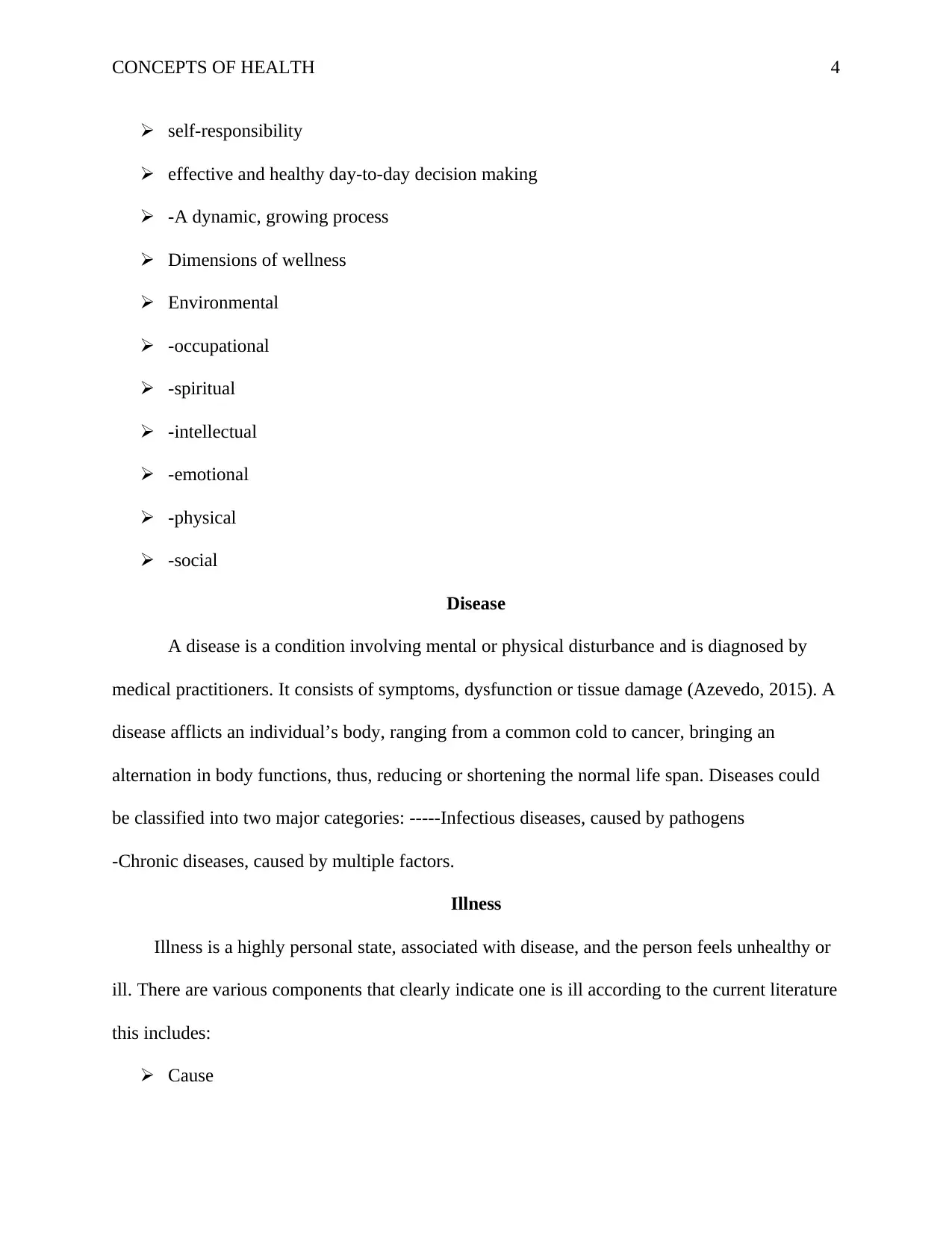
CONCEPTS OF HEALTH 4
self-responsibility
effective and healthy day-to-day decision making
-A dynamic, growing process
Dimensions of wellness
Environmental
-occupational
-spiritual
-intellectual
-emotional
-physical
-social
Disease
A disease is a condition involving mental or physical disturbance and is diagnosed by
medical practitioners. It consists of symptoms, dysfunction or tissue damage (Azevedo, 2015). A
disease afflicts an individual’s body, ranging from a common cold to cancer, bringing an
alternation in body functions, thus, reducing or shortening the normal life span. Diseases could
be classified into two major categories: -----Infectious diseases, caused by pathogens
-Chronic diseases, caused by multiple factors.
Illness
Illness is a highly personal state, associated with disease, and the person feels unhealthy or
ill. There are various components that clearly indicate one is ill according to the current literature
this includes:
Cause
self-responsibility
effective and healthy day-to-day decision making
-A dynamic, growing process
Dimensions of wellness
Environmental
-occupational
-spiritual
-intellectual
-emotional
-physical
-social
Disease
A disease is a condition involving mental or physical disturbance and is diagnosed by
medical practitioners. It consists of symptoms, dysfunction or tissue damage (Azevedo, 2015). A
disease afflicts an individual’s body, ranging from a common cold to cancer, bringing an
alternation in body functions, thus, reducing or shortening the normal life span. Diseases could
be classified into two major categories: -----Infectious diseases, caused by pathogens
-Chronic diseases, caused by multiple factors.
Illness
Illness is a highly personal state, associated with disease, and the person feels unhealthy or
ill. There are various components that clearly indicate one is ill according to the current literature
this includes:
Cause
Paraphrase This Document
Need a fresh take? Get an instant paraphrase of this document with our AI Paraphraser
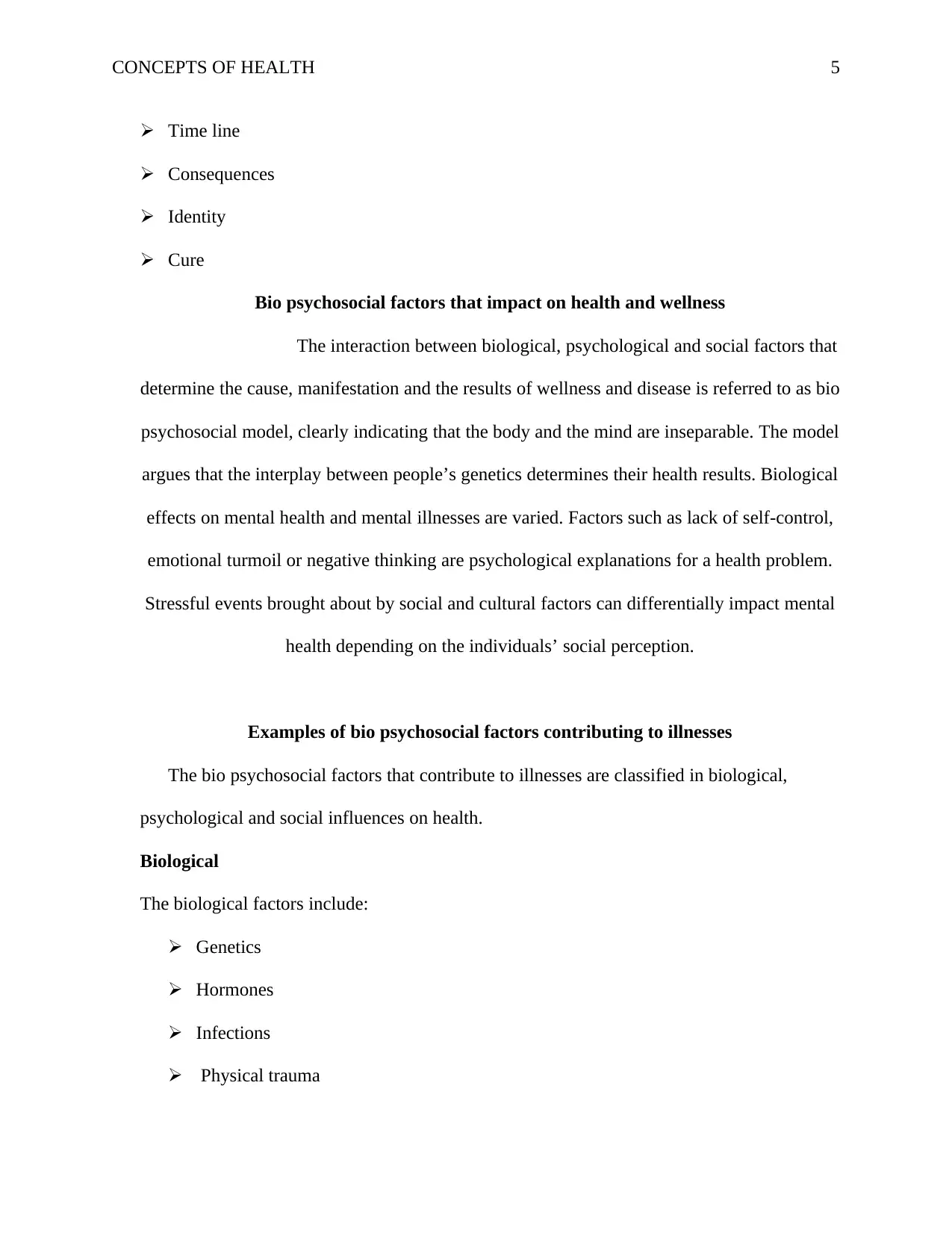
CONCEPTS OF HEALTH 5
Time line
Consequences
Identity
Cure
Bio psychosocial factors that impact on health and wellness
The interaction between biological, psychological and social factors that
determine the cause, manifestation and the results of wellness and disease is referred to as bio
psychosocial model, clearly indicating that the body and the mind are inseparable. The model
argues that the interplay between people’s genetics determines their health results. Biological
effects on mental health and mental illnesses are varied. Factors such as lack of self-control,
emotional turmoil or negative thinking are psychological explanations for a health problem.
Stressful events brought about by social and cultural factors can differentially impact mental
health depending on the individuals’ social perception.
Examples of bio psychosocial factors contributing to illnesses
The bio psychosocial factors that contribute to illnesses are classified in biological,
psychological and social influences on health.
Biological
The biological factors include:
Genetics
Hormones
Infections
Physical trauma
Time line
Consequences
Identity
Cure
Bio psychosocial factors that impact on health and wellness
The interaction between biological, psychological and social factors that
determine the cause, manifestation and the results of wellness and disease is referred to as bio
psychosocial model, clearly indicating that the body and the mind are inseparable. The model
argues that the interplay between people’s genetics determines their health results. Biological
effects on mental health and mental illnesses are varied. Factors such as lack of self-control,
emotional turmoil or negative thinking are psychological explanations for a health problem.
Stressful events brought about by social and cultural factors can differentially impact mental
health depending on the individuals’ social perception.
Examples of bio psychosocial factors contributing to illnesses
The bio psychosocial factors that contribute to illnesses are classified in biological,
psychological and social influences on health.
Biological
The biological factors include:
Genetics
Hormones
Infections
Physical trauma
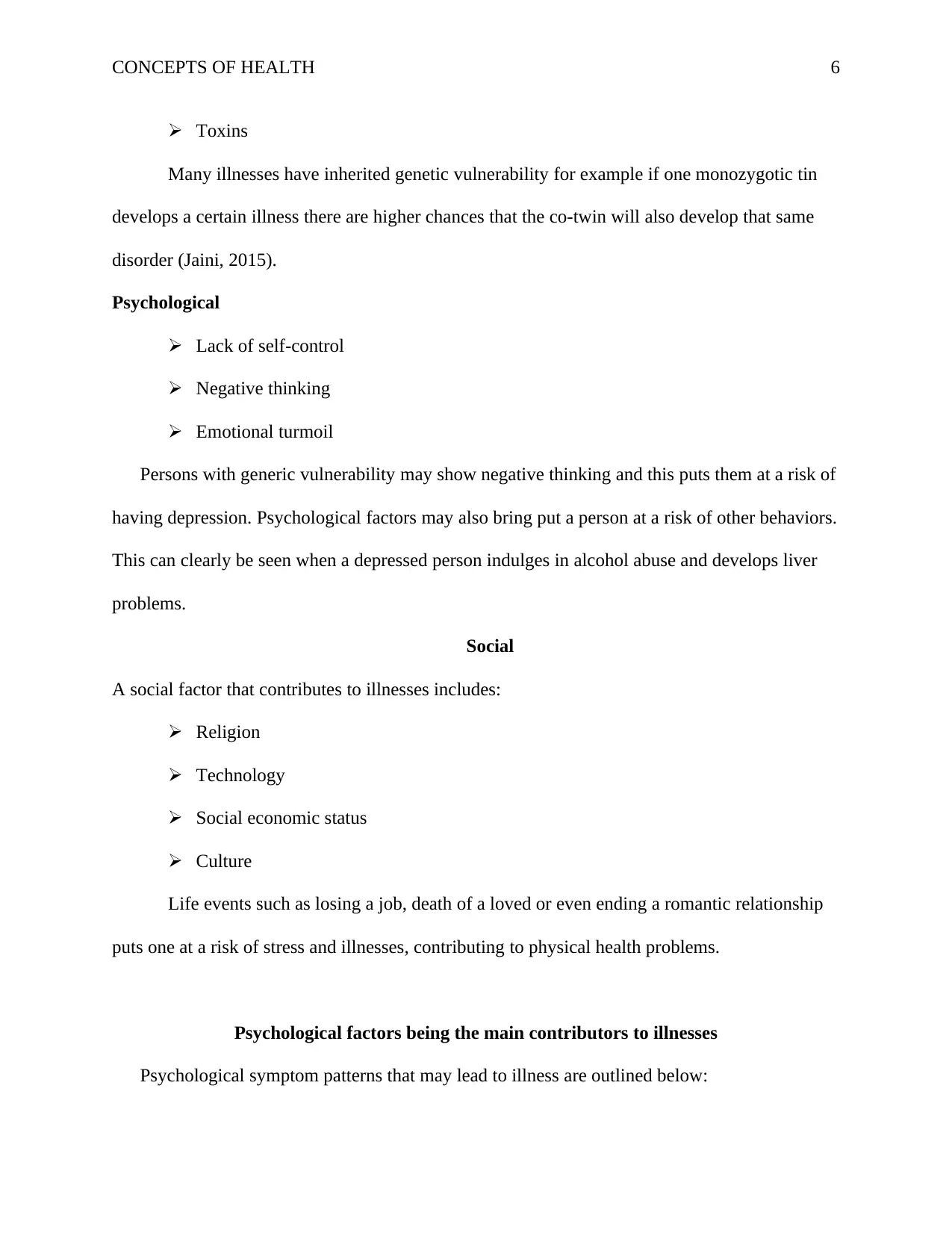
CONCEPTS OF HEALTH 6
Toxins
Many illnesses have inherited genetic vulnerability for example if one monozygotic tin
develops a certain illness there are higher chances that the co-twin will also develop that same
disorder (Jaini, 2015).
Psychological
Lack of self-control
Negative thinking
Emotional turmoil
Persons with generic vulnerability may show negative thinking and this puts them at a risk of
having depression. Psychological factors may also bring put a person at a risk of other behaviors.
This can clearly be seen when a depressed person indulges in alcohol abuse and develops liver
problems.
Social
A social factor that contributes to illnesses includes:
Religion
Technology
Social economic status
Culture
Life events such as losing a job, death of a loved or even ending a romantic relationship
puts one at a risk of stress and illnesses, contributing to physical health problems.
Psychological factors being the main contributors to illnesses
Psychological symptom patterns that may lead to illness are outlined below:
Toxins
Many illnesses have inherited genetic vulnerability for example if one monozygotic tin
develops a certain illness there are higher chances that the co-twin will also develop that same
disorder (Jaini, 2015).
Psychological
Lack of self-control
Negative thinking
Emotional turmoil
Persons with generic vulnerability may show negative thinking and this puts them at a risk of
having depression. Psychological factors may also bring put a person at a risk of other behaviors.
This can clearly be seen when a depressed person indulges in alcohol abuse and develops liver
problems.
Social
A social factor that contributes to illnesses includes:
Religion
Technology
Social economic status
Culture
Life events such as losing a job, death of a loved or even ending a romantic relationship
puts one at a risk of stress and illnesses, contributing to physical health problems.
Psychological factors being the main contributors to illnesses
Psychological symptom patterns that may lead to illness are outlined below:
⊘ This is a preview!⊘
Do you want full access?
Subscribe today to unlock all pages.

Trusted by 1+ million students worldwide
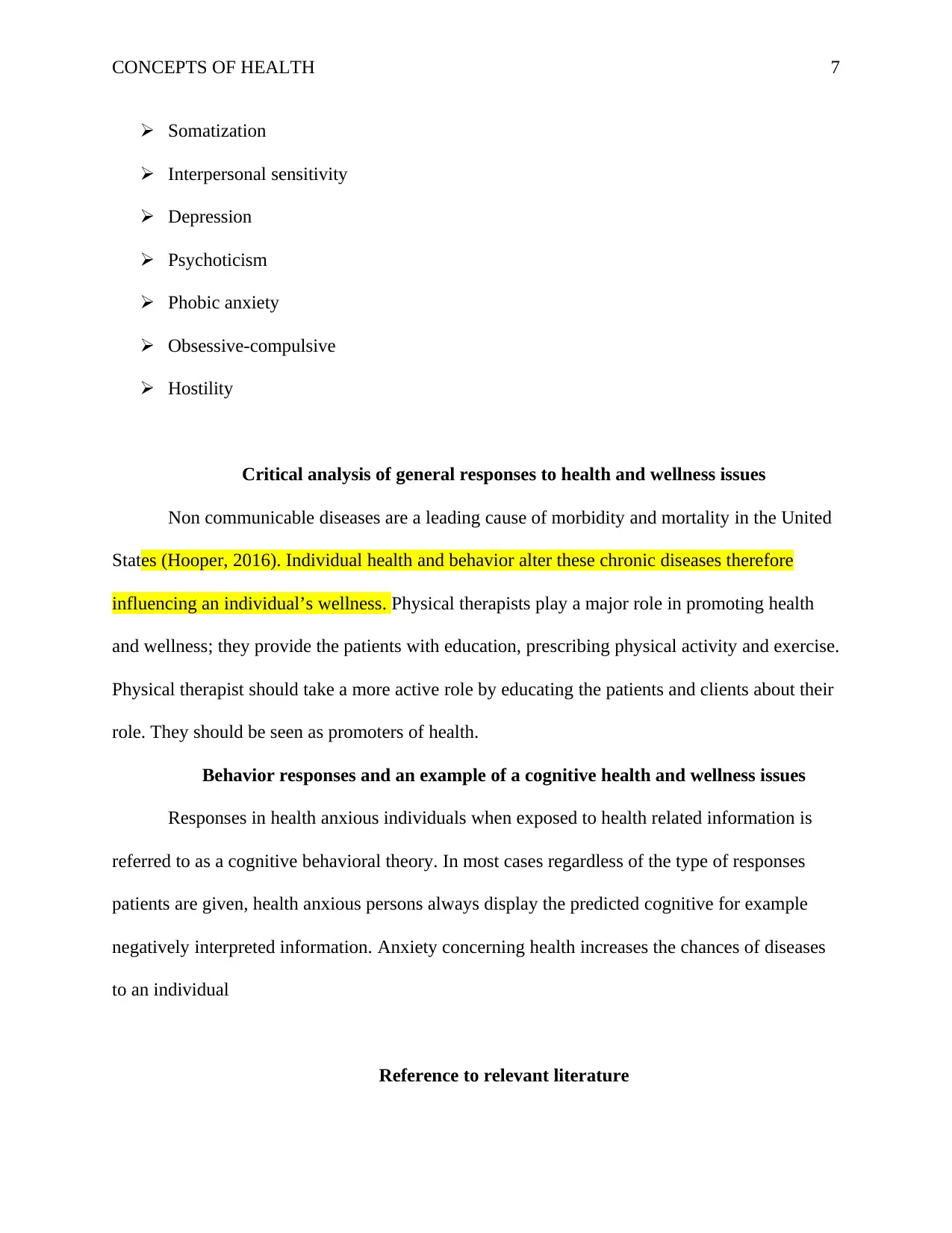
CONCEPTS OF HEALTH 7
Somatization
Interpersonal sensitivity
Depression
Psychoticism
Phobic anxiety
Obsessive-compulsive
Hostility
Critical analysis of general responses to health and wellness issues
Non communicable diseases are a leading cause of morbidity and mortality in the United
States (Hooper, 2016). Individual health and behavior alter these chronic diseases therefore
influencing an individual’s wellness. Physical therapists play a major role in promoting health
and wellness; they provide the patients with education, prescribing physical activity and exercise.
Physical therapist should take a more active role by educating the patients and clients about their
role. They should be seen as promoters of health.
Behavior responses and an example of a cognitive health and wellness issues
Responses in health anxious individuals when exposed to health related information is
referred to as a cognitive behavioral theory. In most cases regardless of the type of responses
patients are given, health anxious persons always display the predicted cognitive for example
negatively interpreted information. Anxiety concerning health increases the chances of diseases
to an individual
Reference to relevant literature
Somatization
Interpersonal sensitivity
Depression
Psychoticism
Phobic anxiety
Obsessive-compulsive
Hostility
Critical analysis of general responses to health and wellness issues
Non communicable diseases are a leading cause of morbidity and mortality in the United
States (Hooper, 2016). Individual health and behavior alter these chronic diseases therefore
influencing an individual’s wellness. Physical therapists play a major role in promoting health
and wellness; they provide the patients with education, prescribing physical activity and exercise.
Physical therapist should take a more active role by educating the patients and clients about their
role. They should be seen as promoters of health.
Behavior responses and an example of a cognitive health and wellness issues
Responses in health anxious individuals when exposed to health related information is
referred to as a cognitive behavioral theory. In most cases regardless of the type of responses
patients are given, health anxious persons always display the predicted cognitive for example
negatively interpreted information. Anxiety concerning health increases the chances of diseases
to an individual
Reference to relevant literature
Paraphrase This Document
Need a fresh take? Get an instant paraphrase of this document with our AI Paraphraser
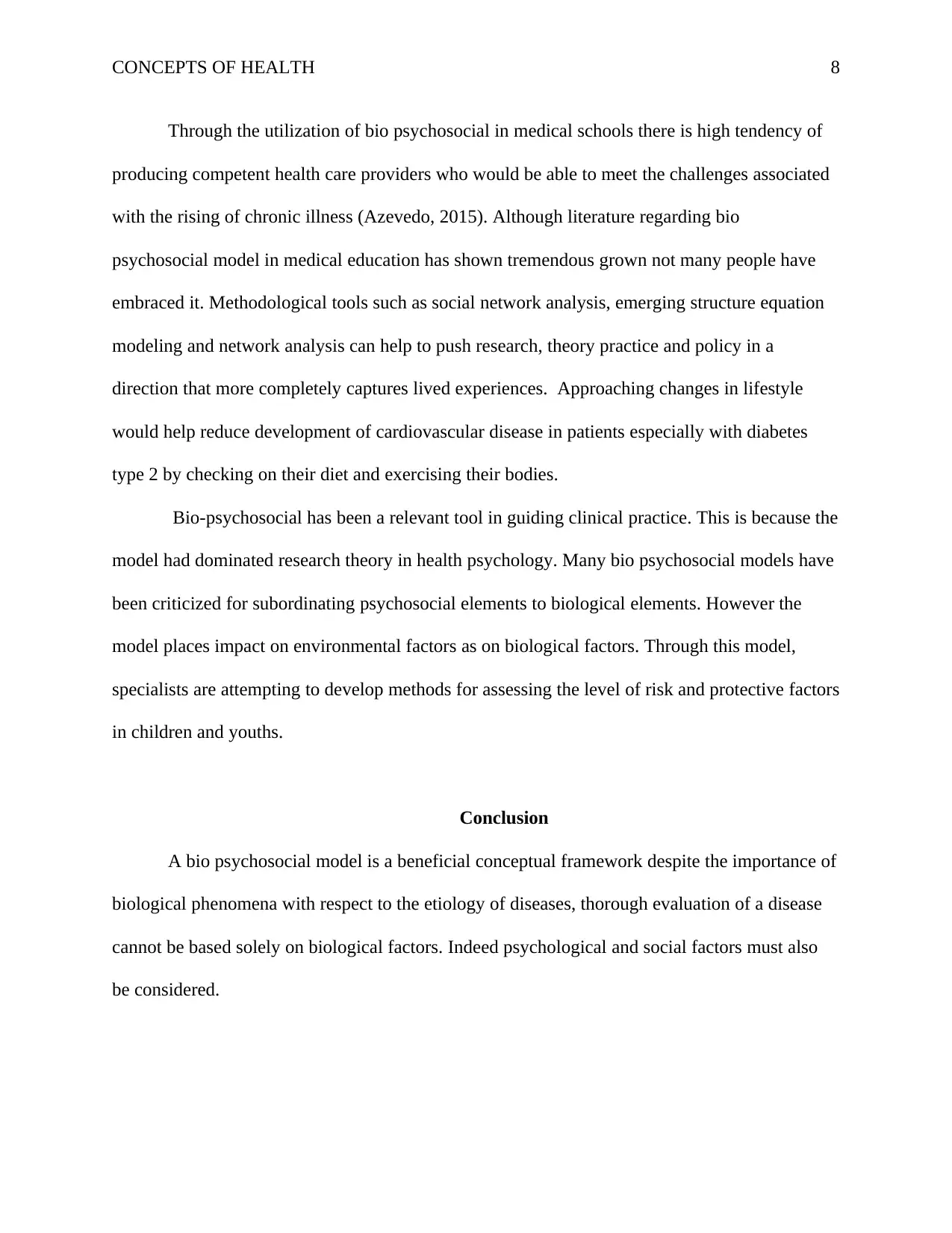
CONCEPTS OF HEALTH 8
Through the utilization of bio psychosocial in medical schools there is high tendency of
producing competent health care providers who would be able to meet the challenges associated
with the rising of chronic illness (Azevedo, 2015). Although literature regarding bio
psychosocial model in medical education has shown tremendous grown not many people have
embraced it. Methodological tools such as social network analysis, emerging structure equation
modeling and network analysis can help to push research, theory practice and policy in a
direction that more completely captures lived experiences. Approaching changes in lifestyle
would help reduce development of cardiovascular disease in patients especially with diabetes
type 2 by checking on their diet and exercising their bodies.
Bio-psychosocial has been a relevant tool in guiding clinical practice. This is because the
model had dominated research theory in health psychology. Many bio psychosocial models have
been criticized for subordinating psychosocial elements to biological elements. However the
model places impact on environmental factors as on biological factors. Through this model,
specialists are attempting to develop methods for assessing the level of risk and protective factors
in children and youths.
Conclusion
A bio psychosocial model is a beneficial conceptual framework despite the importance of
biological phenomena with respect to the etiology of diseases, thorough evaluation of a disease
cannot be based solely on biological factors. Indeed psychological and social factors must also
be considered.
Through the utilization of bio psychosocial in medical schools there is high tendency of
producing competent health care providers who would be able to meet the challenges associated
with the rising of chronic illness (Azevedo, 2015). Although literature regarding bio
psychosocial model in medical education has shown tremendous grown not many people have
embraced it. Methodological tools such as social network analysis, emerging structure equation
modeling and network analysis can help to push research, theory practice and policy in a
direction that more completely captures lived experiences. Approaching changes in lifestyle
would help reduce development of cardiovascular disease in patients especially with diabetes
type 2 by checking on their diet and exercising their bodies.
Bio-psychosocial has been a relevant tool in guiding clinical practice. This is because the
model had dominated research theory in health psychology. Many bio psychosocial models have
been criticized for subordinating psychosocial elements to biological elements. However the
model places impact on environmental factors as on biological factors. Through this model,
specialists are attempting to develop methods for assessing the level of risk and protective factors
in children and youths.
Conclusion
A bio psychosocial model is a beneficial conceptual framework despite the importance of
biological phenomena with respect to the etiology of diseases, thorough evaluation of a disease
cannot be based solely on biological factors. Indeed psychological and social factors must also
be considered.
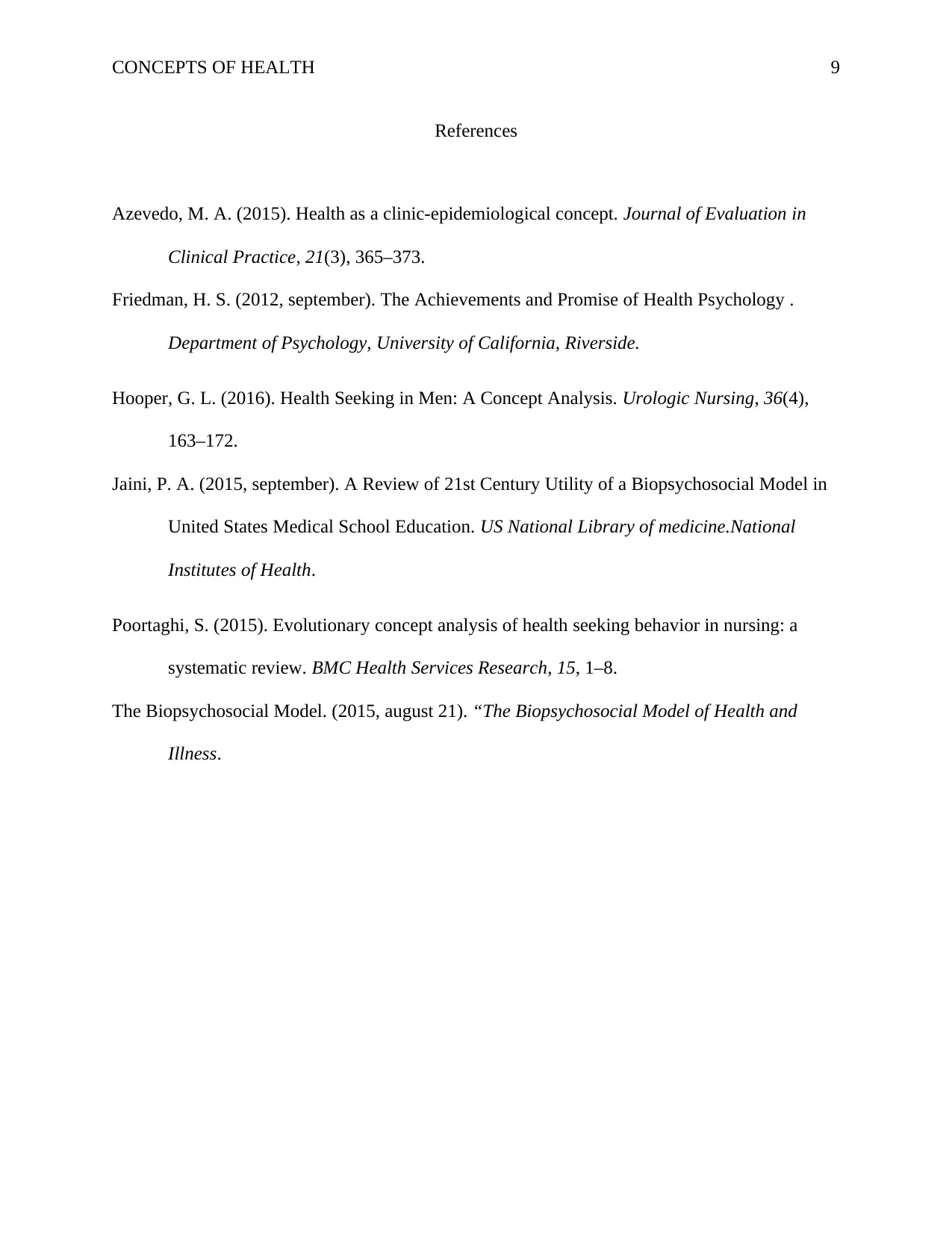
CONCEPTS OF HEALTH 9
References
Azevedo, M. A. (2015). Health as a clinic-epidemiological concept. Journal of Evaluation in
Clinical Practice, 21(3), 365–373.
Friedman, H. S. (2012, september). The Achievements and Promise of Health Psychology .
Department of Psychology, University of California, Riverside.
Hooper, G. L. (2016). Health Seeking in Men: A Concept Analysis. Urologic Nursing, 36(4),
163–172.
Jaini, P. A. (2015, september). A Review of 21st Century Utility of a Biopsychosocial Model in
United States Medical School Education. US National Library of medicine.National
Institutes of Health.
Poortaghi, S. (2015). Evolutionary concept analysis of health seeking behavior in nursing: a
systematic review. BMC Health Services Research, 15, 1–8.
The Biopsychosocial Model. (2015, august 21). “The Biopsychosocial Model of Health and
Illness.
References
Azevedo, M. A. (2015). Health as a clinic-epidemiological concept. Journal of Evaluation in
Clinical Practice, 21(3), 365–373.
Friedman, H. S. (2012, september). The Achievements and Promise of Health Psychology .
Department of Psychology, University of California, Riverside.
Hooper, G. L. (2016). Health Seeking in Men: A Concept Analysis. Urologic Nursing, 36(4),
163–172.
Jaini, P. A. (2015, september). A Review of 21st Century Utility of a Biopsychosocial Model in
United States Medical School Education. US National Library of medicine.National
Institutes of Health.
Poortaghi, S. (2015). Evolutionary concept analysis of health seeking behavior in nursing: a
systematic review. BMC Health Services Research, 15, 1–8.
The Biopsychosocial Model. (2015, august 21). “The Biopsychosocial Model of Health and
Illness.
⊘ This is a preview!⊘
Do you want full access?
Subscribe today to unlock all pages.

Trusted by 1+ million students worldwide
1 out of 9
Related Documents
Your All-in-One AI-Powered Toolkit for Academic Success.
+13062052269
info@desklib.com
Available 24*7 on WhatsApp / Email
![[object Object]](/_next/static/media/star-bottom.7253800d.svg)
Unlock your academic potential
Copyright © 2020–2025 A2Z Services. All Rights Reserved. Developed and managed by ZUCOL.




